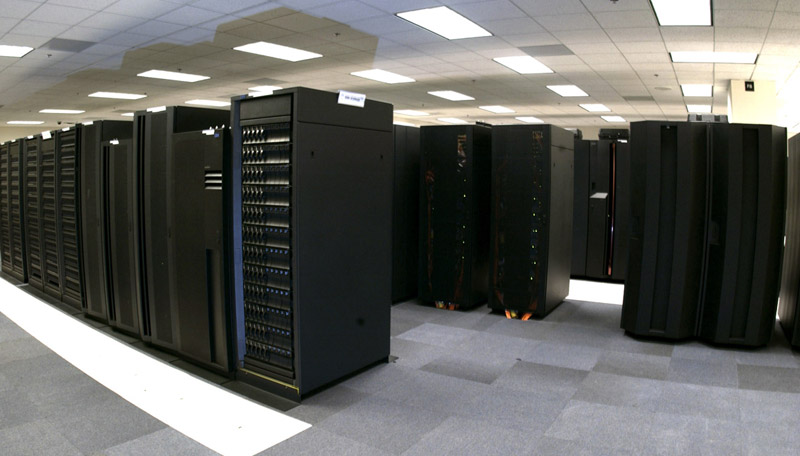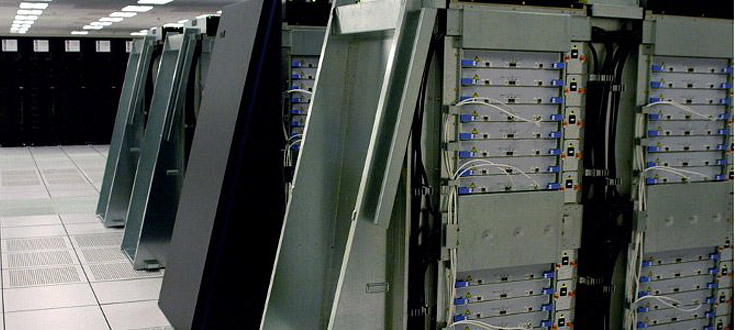Information Technology Blog - - World’s Fastest Supercomputers 2012 - Information Technology Blog
Titan

The Oak Ridge National Laboratory (ORNL) has completed some upgrades to their existing super computer, and they’ve become awfully proud of it. This new supercomputer combines the power of CPUs and GPUs, improving the power of the previous Jaguar supercomputer ten fold. The result: The Titan supercomputer takes up the same footprint of about 200 refrigerators and is said to be capable of calculating 20 petaflops without breaking a sweat. When the news was released about these new upgrades last month, the ORNL was confident the Titan would be the world’s fastest supercomputer. Now, the Top 500 List of the World’s Top Supercomputers has agreed, saying their Titan machine is indeed the fastest machine in the world.
The Titan, a Cray XK7 system with 560,640 processors and 261,632 NVIDIA K20x accelerator cores achieved just shy of the projected 20 petaflop marking, calculating 17.59 petaflops, or quadrillions of calculations per second.
Titan beat out the previous number one contender, Sequoia of Lawrence Livermore National Laboratory. Sequoia, a supercomputer built on top of the IBM BlueGene/Q system, has now been moved to second place. During the last Top 500 tests this past June, the Sequoia used it’s 1,572,864 cores to churn out 16.32 petaflops. According to the Top 500 statement, Sequoia is also the first machine to house 1 million or more cores.
Elsewhere in the top 5 of the top 500 list are machines from Japan, Chicago and Germany. Fujitsu’s K computer came in at number 3, and is housed at the RIKEN Advanced Institute for Computational Science (AICS) in Kobe, Japan. The BlueGene/Q system performed very well in the most recent Top 500, backing the 2nd, 4th and 5th place machines. The 4th Place BlueGene/Q system supports Mira, a supercomputer from Argonne National Laboratory outside of Chicago, Illinois. JUQUEEN at the Forschungszentrum Jülich in Germany scored number 5 and is also supported on the IBM BlueGene/Q architecture. Though JUQUEEN scored number 5 in the world, it was named the most powerful supercomputer in Europe.
A Dell PowerEdge C8220 system at the University of Texas at Austin by the name of Stampede also made the top ten list. This system uses the new Intel Xeon Phi processors, capable of working out 2.6 petaflops, much less than Titan’s 17.59.
According to Top500.org, Titan isn’t the only computer to combine CPU and GPU to achieve its high speeds. There are now a total of 62 systems in the Top 500 list which make use of the same principal, including number 8 on the list, the Chinese system Tianhe-1A. This supercomputer uses NVIDIA GPUs. When the last Top 500 list was released 6 months ago, there were 58 systems which took the hybrid approach.
The Top 500 list also acknowledges Intel, saying 76% of the Top 500 rated supercomputers make use of their processors. The AMD Opteron is used in 12% of these supercomputers (a total of 60 systems) while IBM Power Processors are used in 10.6% of these systems.
The USA is well-represented in this list with 250 of the 500 systems. Asia comes in second in terms of most High Powered Computers (HPC) per country at 124, with Europe coming in at number 3 with 105 systems.
While China comes in at number 2 for users of HPC, (they have a total of 72 systems) they fall behind Japan in terms of performance, where Japan holds the number 2 position.
Source: Titan Now Officially The World’s Fastest Computer
Every six months, a new list of the top 500 fastest supercomputers in the world comes out. Notable news today is that 10 petaflops has been reached.
Top500 systems are using processors of six or more cores, and almost 80% of the processors in the entire list are made by Intel. On average, a supercomputer produces 282 megaflops for every watt of power it consumes, but the fastest supercomputer of all manages to crank out 830 megaflops per watt, making it one of the most efficient systems on the list. Below is a list of the top 5 supercomputers of the world today. Speed is measured by petaflops. (In computing, FLOPS (or flops or flop/s, for floating-point operations per second) is a measure of a computer’s performance, especially in fields of scientific calculations that make heavy use of floating-point calculations, similar to the older, simpler, instructions per second.)
K Computer, Japan. 10.5 petaflops
Japan’s “K Computer” had the #1 spot six months ago at over eight petaflops, but it’s increased its speed to an epic ten and a half petaflops. A petaflop, by the way, is a peta’s worth of flops, which is 1,000,000,000,000,000 (a quadrillion) flops per second. And while we’re on the subject, a flop is a FLoating point OPeration, which is something that computers have to do a lot of when making scientific calculations, which is why flops are used to measure supercomputing speed.

A new Japanese supercomputer has just become the fastest computer on Earth. And it didn’t just squeak by into the top spot: it beat the 2nd fastest computer on Earth by being three times faster.
The K Computer has a processing power of more than 8 petaflops. What’s that mean? It means it can process 8 quadrillion calculations per second. Maybe that number will be more impressive to you in numeric form: 8,000,000,000,000,000 calculations per second. It’s faster than 28,000
And they aren’t done yet! The goal is to get it up to 10 petaflops by 2012, which I guess is reasonable if you’re already at 8 petaflops.
The K Computer was built by Fujitsu and lives at the RIKEN Advanced Institute for Computational Science in Kobe, Japan, where it will work on projects “ranging from global climate research, meteorology, disaster prevention, and medicine.”
Tianhe 1-A, China. 2.5 petaflops
Tianhe-1A, named for the Milky Way, is capable of sustained computing of 2.507 petaflops – equivalent to 2,507 trillion calculations each second.

Housed in the northern port city of Tianjin, near Beijing, Tianhe-1A was developed by the National University of Defence Technology. The system was built from thousands of chips made by US firms – Intel and Nvidia – but domestic researchers developed the networking technology that allows information to be exchanged between servers at extraordinary speeds.
Tianjin’s weather bureau and the National Offshore Oil Corporation data centre are already using it for trial projects. “It can also serve the animation industry and bio-medical research,” Liu Guangming, director of the National Centre for Supercomputing, told China Daily.
Cray Jaguar, United States. 1.7 petaflops
The Jaguar system consists of an 84 cabinet quad-core Cray XT4 system and 200 upgraded Cray XT5 cabinets, using six-core processors. The XT4 has 8 gigabytes of memory per node while the XT5 has 16 gigabytes per node, giving the users a total of 362 terabytes of high-speed memory in the combined system. The two systems are connected to the Scalable I/O Network (SION), which links them together and to the Spider file system. The XT5 system has 256 service and I/O nodes providing up to 240 gigabytes per second of bandwidth to SION and 200 gigabits per second to external networks. The XT4 has 116 service and I/O nodes providing 44 gigabytes per second of bandwidth to SION and 100 gigabits per second to external networks.

Upgrade: Supercomputer builder Cray on Tuesday said it will upgrade the Department of Energy’s Jaguar computer so it can run nearly 10 times faster and challenge a Japanese computer to regain its standing as the world’s fastest computer.
The Jaguar was the world’s fastest computer when Cray built it in 2008 for the Oak Ridge National Laboratory in Tennessee. Today, it’s the world’s third-fastest computer, according to a list compiled by computer researchers.
Under the $97 million contract, Cray will swap out the Jaguar’s more than 224,000 processors made by Advanced Micro Devices Inc. and replace them with a combination of updated AMD processors and graphics chips from Nvidia Corp.
Graphics chips, which are designed to crunch numbers for 3-D environments, are finding increasing use in supercomputers.
Cray said the first phase of the upgrade will be completed this year. Additional Nvidia chips will be added next year.
The new computer will be called Titan.
Dawning Nebulae, China. 1.27 petaflops
Dawning Nebulae supercomputer is built by Insti- tute of Computing Technology of Chinese Academy of Sciences, in collaboration with Dawning Informa- tion Industry Corp. It will be deployed at the Na- tional Supercomputing Center in Shenzhen, Guang- dong Province, to power the CNGrid Southern-China backbone node. It is the ?rst supercomputer in China, and the third one in the world, which broke the one petaFLOPS Linpack performance barrier.

Tsubame 2.0, Japan. 1.91 petaflops
To advance science by computational modeling and simulations, a large-scale supercomputer TSUBAME* was deployed at GSIC in 2006, and has been providing computing and storage resources for research at Tokyo Tech. The machine has also been made available to select projects at outside research institutes and industries.

TSUBAME is also established to foster advanced education in computer and computational sciences, and is open to every student at the university, including undergraduates.
Sources:
Meet the 5 fastest computers on the planet
FLOPS
Tianhe-I
What is Tsubame?
Related: The History of Super Computers
Related: Worlds Fastest Supercomputers 2015
Thank you for reading IT Blog
Originally posted 2012-11-14 17:52:00. Republished by Blog Post Promoter
The post World’s Fastest Supercomputers 2012 appeared first on Information Technology Blog.
0 Response to "World’s Fastest Supercomputers 2012"
Post a Comment
THANK YOU